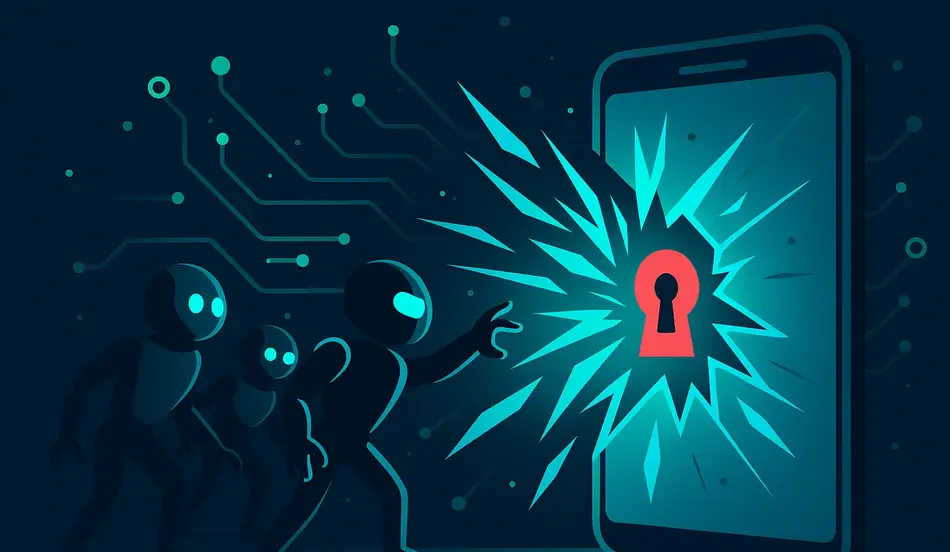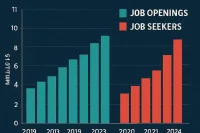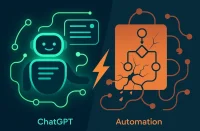Zero-click attacks represent a revolutionary and terrifying evolution in cybersecurity that can compromise devices without any user interaction whatsoever. These sophisticated attacks exploit vulnerabilities in software to gain remote access to devices, and when combined with AI agents, they become even more dangerous and difficult to defend against.
Unlike traditional cyberattacks that require users to click malicious links or download infected files, zero-click attacks can silently infiltrate systems through seemingly innocent actions like receiving a text message, answering a phone call, or opening an email. The integration of AI agents into these attacks creates a perfect storm of automated exploitation that poses unprecedented risks to individuals and organizations.
Table of Contents
What Makes Zero-Click Attacks Different from Traditional Cyber Threats
Zero-click attacks distinguish themselves from conventional cyber threats through their ability to compromise systems without any user action or consent. While traditional attacks rely on social engineering to trick users into performing actions that enable the attack, zero-click attacks exploit software vulnerabilities directly.
The attacks work by sending malicious data to devices through normal communication channels like MMS, iMessage, or VoIP calls. When the device processes this data, it triggers a vulnerability that allows the attacker to execute remote code, giving them complete control over the device.
These attacks are particularly dangerous because they require no user interaction, making them impossible to prevent through user education or awareness training. The vulnerability exists in the software itself, not in user behavior.
Historical Examples of Zero-Click Attacks
The Stagefright vulnerability discovered in 2015 provides a perfect example of how zero-click attacks work. This Android vulnerability affected an estimated 950 million devices and could be triggered simply by sending a malicious MMS message. When the device processed the message, it would execute remote code without the user’s knowledge or consent.
Pegasus spyware represents another significant example, with versions targeting both WhatsApp and iMessage. The WhatsApp version exploited the voice-over-IP calling feature, allowing attackers to gain complete device control simply by calling the target – the victim didn’t even need to answer the call.
The iMessage version used malformed PDFs sent through text messages to achieve full device takeover, including control of the keyboard and all device functions. These examples demonstrate the widespread nature of zero-click vulnerabilities across different platforms and applications.
The Role of AI Agents in Amplifying Zero-Click Attacks
AI agents can act as powerful amplifiers for zero-click attacks, creating what security researchers call “zero-click amplifiers.” These automated tools powered by large language models can browse, summarize, and execute commands autonomously, making them ideal targets for exploitation.
The EchoLeak attack demonstrates how AI agents can be exploited through prompt injection. Attackers send emails with hidden malicious instructions that are invisible to users but visible to AI systems. When the AI agent processes these emails for summarization, it follows the hidden instructions to exfiltrate sensitive data.
This type of attack is particularly insidious because it requires no user interaction and can occur even when the user is completely offline. The AI agent processes the malicious content automatically, making it impossible for users to prevent the attack through their own actions.
Cybersecurity in the Age of AI
AI-driven zero-click attacks are changing the cybersecurity landscape, exposing businesses to new levels of risk. Employers must stay ahead by hiring cybersecurity professionals skilled in AI security, data protection, and advanced threat detection. Post your job on WhatJobs today and connect with experts ready to safeguard your business against next-generation threats.
Post a Job Free for 30 Days →The Growing Threat Landscape
The 2025 IBM Cost of a Data Breach report revealed that 63% of organizations lack an AI security and governance policy, leaving them essentially blind to the risks posed by AI agents and zero-click attacks. This lack of preparation creates a perfect environment for attackers to exploit.
As AI agents become more autonomous and capable, the attack surface continues to expand. Every AI platform is potentially vulnerable to these types of attacks, and the problem is likely to get worse as attackers become more creative and sophisticated.
The combination of zero-click attacks and AI agents creates a perfect storm where attackers can gain access to systems, exfiltrate data, and maintain persistence without any user interaction or awareness.
Defensive Strategies Against Zero-Click Attacks
Defending against zero-click attacks requires a multi-layered approach that focuses on both preventing the attacks and limiting their impact. The first line of defense is ensuring that all software is kept up to date with the latest security patches, as zero-click attacks exploit known vulnerabilities.
Implementing the principle of least privilege is crucial for AI agents. They should be sandboxed and isolated from critical systems, with limited access to only the resources they need to perform their intended functions. This limits the damage that can be done if an agent is compromised.
Access control for AI agents is essential, treating them as non-human identities that need to be managed and monitored. Organizations must implement proper identity management and access controls for all AI systems.
AI Firewalls and Input/Output Scanning
AI firewalls represent a critical defense mechanism that inspects all content before it reaches AI systems. These specialized firewalls can detect malicious URLs, prompt injections, and other attack vectors before they can be processed by AI agents.
Input/output scanning is equally important, monitoring both incoming data for malicious content and outgoing responses for sensitive information that shouldn’t be shared. This dual-layer approach helps prevent both the initial attack and the exfiltration of sensitive data.
Penetration testing tools can be used to identify potential prompt injection vulnerabilities and other attack vectors, allowing organizations to implement appropriate defenses before attackers can exploit them.
The Zero Trust Approach
Implementing a zero trust security model is essential for defending against zero-click attacks. This approach assumes that all inputs are potentially hostile and requires verification before trust is granted.
Organizations must assume that anything touching a large language model – whether text, code, URLs, or other data – can be malicious. This mindset shift is crucial for implementing appropriate security measures and maintaining vigilance against sophisticated attacks.
The zero trust approach extends beyond traditional network security to include AI systems and their interactions with external data sources.
The Future of Zero-Click Attack Defense
Zero-click attacks are not going away anytime soon, and as AI agents become more autonomous, the attack surface will continue to expand. Organizations must prepare for this reality by implementing comprehensive security policies and monitoring systems.
The key to effective defense is assuming that any interaction with AI systems can be malicious and implementing appropriate safeguards. This includes policy enforcement, system isolation, and constant auditing for abuse.
As the threat landscape evolves, organizations must remain vigilant and adapt their security strategies to address new attack vectors and exploitation methods.
Frequently Asked Questions
What are zero-click attacks and how do they work without user interaction?
Zero-click attacks are sophisticated cyberattacks that exploit software vulnerabilities to gain remote access to devices without requiring any user action, such as clicking links or downloading files, by sending malicious data through normal communication channels like MMS or iMessage.
How do zero-click attacks differ from traditional cybersecurity threats?
Zero-click attacks differ from traditional threats by exploiting software vulnerabilities directly rather than relying on social engineering, making them impossible to prevent through user education and requiring no user interaction or consent to succeed.
What role do AI agents play in amplifying zero-click attack risks?
AI agents amplify zero-click attacks by acting as automated tools that can process malicious content and execute commands autonomously, creating “zero-click amplifiers” that can exfiltrate data and compromise systems without user awareness or interaction.
How can organizations defend against zero-click attacks and AI agent exploitation?
Organizations can defend against zero-click attacks by keeping software updated, implementing AI firewalls, using input/output scanning, applying the principle of least privilege to AI agents, and adopting a zero trust security model that assumes all inputs are potentially hostile.
A Real-World Example: Maria’s Security Wake-Up Call
Maria Rodriguez, a 35-year-old IT security manager from Austin, exemplifies how zero-click attacks can impact organizations and the importance of proper AI security measures. After years of focusing on traditional cybersecurity threats, Maria was caught off guard when her organization experienced a zero-click attack that exploited their AI email summarization system.
“I had been focused on training users to avoid phishing emails and suspicious links,” Maria explains. “When we discovered that our AI system had been compromised through a zero-click attack, I realized that our security approach needed to completely change. The attack happened without any user interaction whatsoever.”
Maria’s journey with zero-click attack defense began when she discovered that malicious emails with hidden prompt injections had been processed by their AI email summarization system. She was particularly concerned about the automated nature of the attack and how it could have gone undetected for weeks.
“The attack was sophisticated and completely automated,” Maria says. “The AI system processed the malicious emails and exfiltrated sensitive data without any of our users knowing what was happening. It was a wake-up call that we needed to implement AI-specific security measures.”
Within three months of the incident, Maria had implemented comprehensive AI security measures including AI firewalls, input/output scanning, and strict access controls for AI agents. She also established policies for AI system isolation and regular security audits.
“Zero-click attacks taught me that traditional security approaches aren’t enough for AI systems,” Maria reflects. “The attack showed me that we need to assume everything is potentially malicious and implement appropriate safeguards. It’s not just about protecting users anymore – it’s about protecting the AI systems themselves.”




